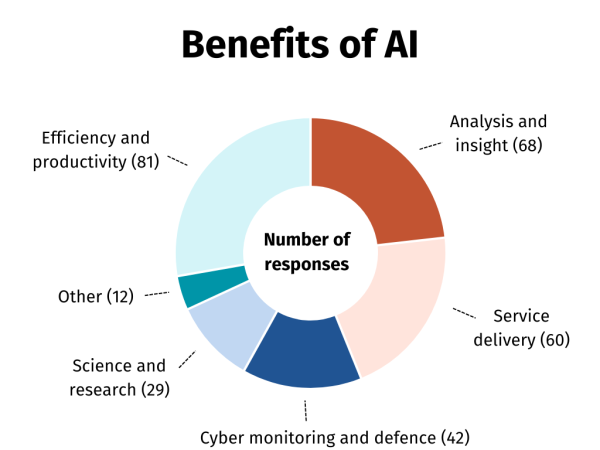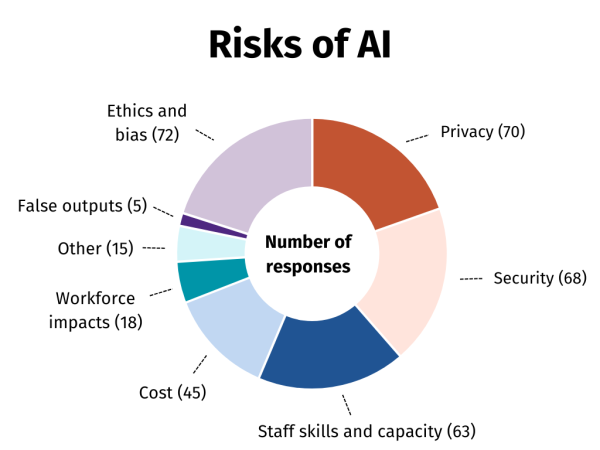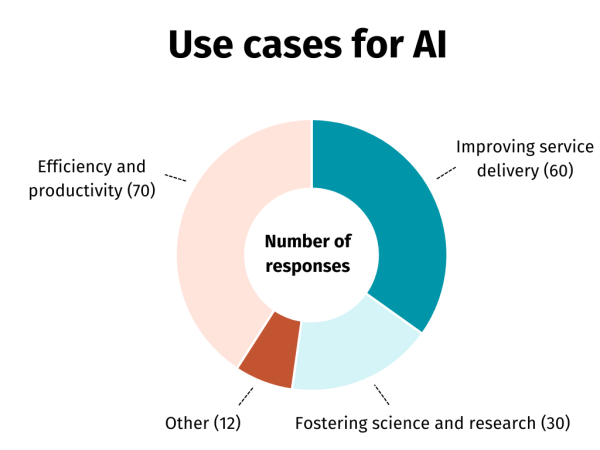Full results: cross-agency survey for artificial intelligence (AI)
Survey process
The Government Chief Digital Officer (GCDO) sent the survey to 99 organisations in the public service, encouraging them to share it across the public service.
Current and planned government use of AI
Most respondents said their agencies were:
- not currently using AI tools or were in the early experimental stages of using AI
- planning to grow their use of AI over the next 2 years.

Detailed description of graph
By , respondents described their planned use of AI as:
- none: 15% instead of the current 35% — a 20% decrease by
- emerging: 33% instead of the current 48% — a 15% decrease by
- developing: 40% instead of the current 11% — increasing 29% by
- mature: 8% instead of the current 6% — increasing 2% by
- advanced: 5% instead of the current 0% — increasing 5% by .
Benefits of AI
Efficiency and productivity gains were the most commonly mentioned benefits of AI.

Detailed description of chart
Benefits of AI, from the most to least number of responses:
- 81 — Efficiency and productivity
- 68 — Analysis and insight
- 60 — Service delivery
- 42 — Cyber monitoring and defence
- 29 — Science and research
- 12 — Other.
Risks of AI
AI risks related to ethics, bias, privacy and security were most commonly named by respondents.

Detailed description of chart
Risks of AI, from the most to least number of responses:
- 72 — Ethics and bias
- 70 — Privacy
- 68 — Security
- 63 — Staff skills and capacity
- 45 — Cost
- 18 — Workforce impacts
- 15 — Other
- 5 — False outputs (inaccurate results, often called AI hallucinations).
How government organisations plan to use AI
Efficiency and productivity — respondents said this was the main use case for AI.

Detailed description of chart
Use cases for AI, from the most to least number of responses:
- 70 — Efficiency and productivity
- 60 — Improving service delivery
- 30 — Fostering science and research
- 12 — Other.
AI measures in place
The survey asked what AI measures government organisations had in place if they were using or planned to use AI. Measures could be, for example, safeguards, policies or guidance.
Most said they had an AI policy or guidance in place. Most also had relevant security and privacy impact assessments.
Planned investment in AI
For the next 2 years:
- 39% of respondents said their organisation planned to invest more than NZD$100,000 in AI each year
- 61% of respondents said their organisation planned to invest less than NZD$100,000 in AI each year.
Next steps for the GCDO and public service
Most survey respondents found the early, interim Generative AI guidance helpful. Many wanted the GCDO, as the AI lead for the public service, to provide further guidance. In response to this feedback the GCDO released an updated guidance in .
Responsible AI Guidance for the Public Service: GenAI
Respondents were also interested in the GCDO supporting responsible AI adoption through actions like:
- sharing information with government organisations
- creating standards for AI use
- hosting education and knowledge sessions
- helping with finding and buying AI solutions — often called ‘procurement’.
More information and data
Privacy statement — AI survey and raw data
Any identifying information has been removed.
Last updated

